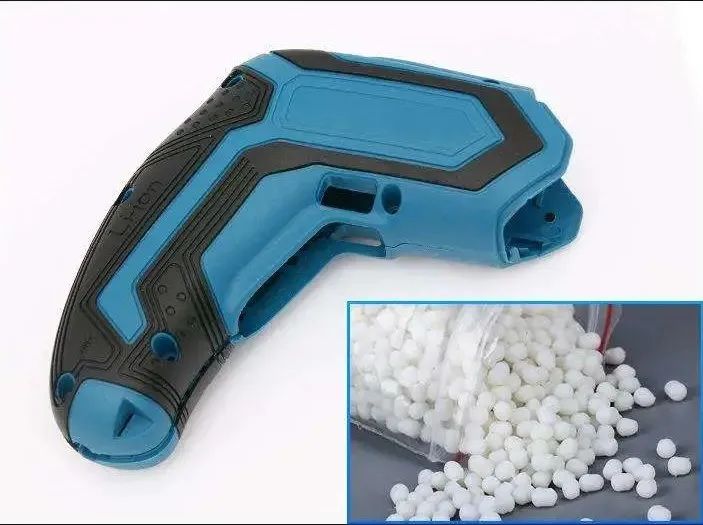Utilizing graft modified elastomer as the dispersion phase and plastic as the matrix to mix and toughen is the primary technique of plastic toughening, which may significantly increase the impact strength of plastics. Elastomer, which is a dispersed phase, primarily influences the toughness of elastomer/plastic mixes from the eight factors listed below.

01 Effect of the distance between elastomer particle spacing
The distance ID of the elastomer particles has a crucial value IDc for toughened polymers. The brittle-ductile transition won’t take place and the toughness won’t appreciably increase until the ID between elastomer particles in the dispersed phase is less than the crucial value IDc.
This is due to the fact that the mix is still brittle when the distance between elastomer particles is significant because the stress field around the particles has minimal impact on other particles and the stress field in the matrix is merely the sum of the stress fields of these isolated particles. The matrix layer of the dispersed phase will thin and the plastic zones at the tips of the silver crests will interact with one another when the particles are sufficiently close to the critical point, however, at which point the stress field is no longer a simple summation. The crazes were prevented from expanding once the strain state changed to plane strain, the matrix layer provided shear yield, and the blend produced yield.
2. Elastomer content’s impact
The rate of craze initiation, branching, and termination increases together with the elastomer content in the plastic matrix, and the impact strength rises as a result. The interparticle distance of the dispersed phase can only reach the crucial value IDc when the content of the elastomer reaches a particular number of parts, hence the toughening effect won’t be visible until the elastomer content reaches that number of parts.
3. Elastomer particle size effects
Numerous investigations have demonstrated that elastomer particles that are either too big or too small cannot successfully start crazes or stop them in their tracks for a particular type of plastic.
The POE particles in the PBT matrix are too big to start and stop crazes with equal amounts of addition, therefore the toughening effect is not readily apparent. Since W1A-2(POE-g-GMA) in PBT has relatively moderate particle size, it can significantly increase impact strength. Additionally, since the brittle-ductile transition’s critical particle distance IDc is relatively low for resins with high brittleness, under the assumption of any addition, the toughening impact will be greater the smaller the elastomer’s particle size.

04 Elastomer Glass Transition Temperature Influence
The flexibility of the molecular chain and the toughening impact on plastics, particularly the low-temperature toughening effect, are generally better the lower the glass transition temperature of the dispersed phase elastomer.
05 Effect of elastomer and matrix resin compatibility
If the compatibility between the elastomer phase and the resin phase is excessively excellent or excessively bad, it is not good. though the compatibility is too excellent, the size of the elastomer is too tiny, and even though it forms a homogenous system, it won’t have a decent toughening effect. If the compatibility is too bad, the adhesion between the two phases is insufficient.
06 Effects of resin inclusion content on colloidal particles
A stronger toughening effect is achieved at a smaller weight fraction of the elastomer thanks to the resin’s incorporation into the elastomer particles, which enhances the effective volume of the elastomer phase. However, if there are too many inclusions, the elastic body’s modulus will rise to levels that are too close to the modulus of the resin phase and lose its capacity to start and stop silver crazing. This will prevent the material from toughening. This means that the amount of resin inclusions has a best value as well.
07 Elastomer crosslinking degree’s impact
The elastomer’s degree of crosslinking has a sufficient range. It will be challenging to exert the toughening effect if the crosslinking is too high, the elastomer’s modulus is too high, and the elastomer’s characteristics are lost. The elastomer particles are readily bent and fractured under the action of shear during processing if the degree of cross-linking is low, which is also not favorable to enhancing the toughening performance of the elastomer phase.
08 Elastic Modulus Influence
El módulo del elastómero aumenta como fase dispersa, lo que va en detrimento del endurecimiento.
According to the figure below, the simpler it is to produce brittle-ductile transition for the same matrix resin, the lower the dispersed phase’s elastic modulus.
In order for the plastic to undergo the brittle-ductile transition and have a satisfactory toughening effect, the volume fraction of the elastomer must typically reach a certain value and the particle spacing must be less than the critical value. To create polymers with particularly high toughness, you should use plastic elastomer tougheners with lower glass transition temperatures, reduced modulus, moderate crosslinking, and moderate compatibility with the matrix.











